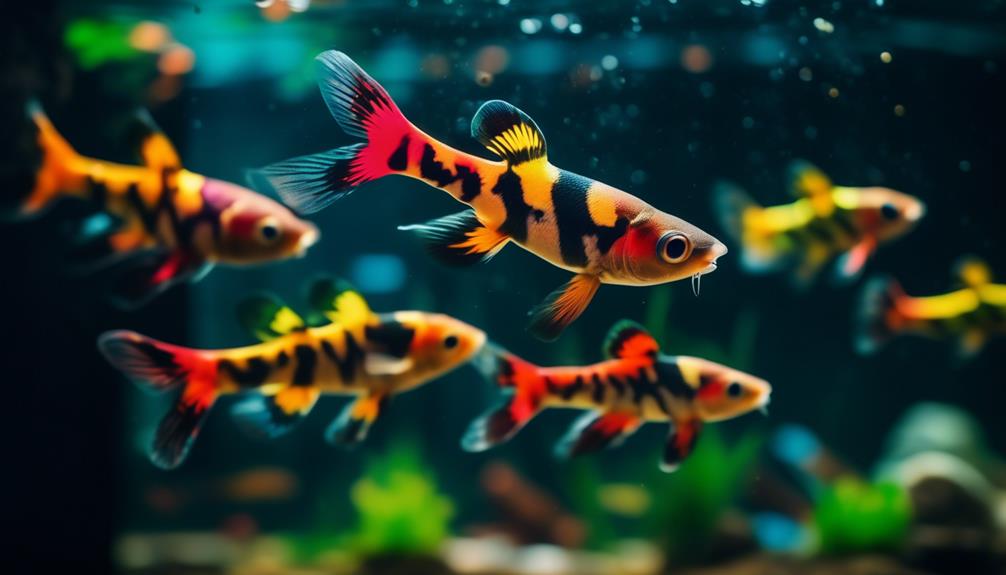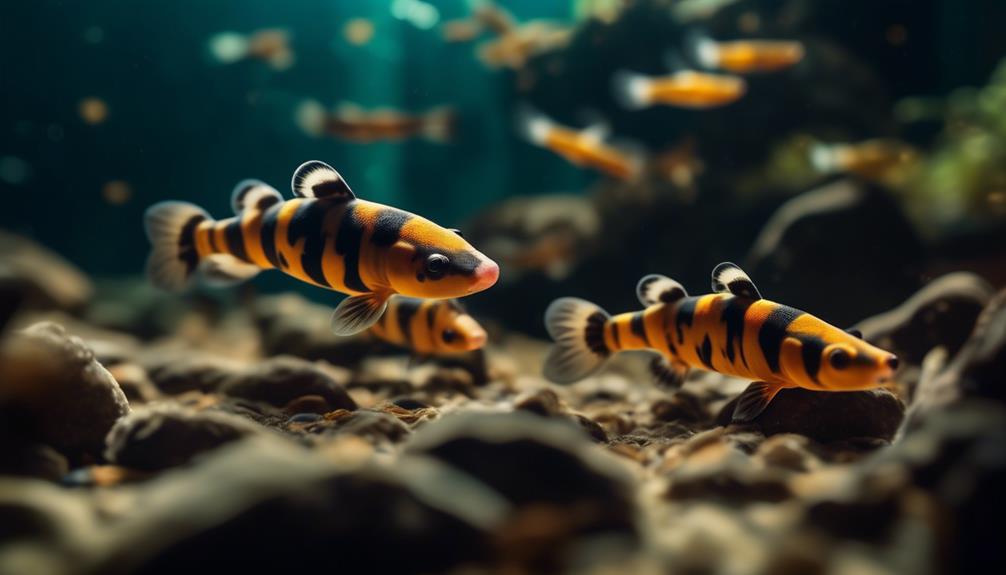In the vast realm of aquatic creatures, few can match the captivating allure of loaches. These extraordinary fish possess a charm that is both enchanting and intriguing.
From their mesmerizing patterns to their mesmerizing behaviors, loaches have a unique ability to captivate the attention of aquarium enthusiasts. But there is more to these aquatic wonders than meets the eye.
As the discussion unfolds, prepare to be amazed by the hidden secrets and remarkable qualities that make the world of loaches truly fascinating.
Key Takeaways
- Loaches are diverse and fascinating fish that make great additions to aquariums.
- Different species of loaches have unique characteristics and behaviors, such as the puppy-like behavior of Clown Loaches or the nocturnal scavenging of Kuhli Loaches.
- Loaches can serve practical purposes in aquariums, such as controlling snail populations or eating algae.
- It's important to provide the appropriate environment and care for loaches to thrive and live a long, healthy life.
Popular Loach Species
Loach species, such as the Clown Loach, Kuhli Loach, and Reticulated Hillstream Loach, are popular choices among aquarium enthusiasts due to their unique characteristics and adaptability to various tank conditions.
When it comes to loach breeding, these species can be relatively easy to breed with the right conditions and care. A proper loach tank setup is essential for successful breeding. It's recommended to provide hiding places, such as caves or plants, to mimic their natural habitat and facilitate spawning.
Additionally, maintaining optimal water parameters, including temperature, pH, and water quality, is crucial for the health and well-being of the loaches and their offspring.
Unique Loach Behaviors
Loaches exhibit a variety of unique behaviors that make them fascinating additions to aquariums. One interesting feeding habit of loaches is their ability to sift through substrate in search of food. They use their barbels, which are sensory organs located around their mouths, to detect and consume small invertebrates and food particles.
Some loach species, like the Kuhli Loach, are nocturnal and prefer to scavenge for food during the night.
When it comes to loach breeding, it's important to provide them with suitable conditions in order to encourage successful reproduction. This includes providing hiding spots and plants for the female to lay her eggs, as well as maintaining proper water parameters. Additionally, providing a varied diet and ensuring the loaches are in optimal health can increase the chances of successful breeding.
Loaches for Snail Control

One intriguing aspect of loach behavior is their potential for serving as natural snail control in aquariums, making them a valuable asset for maintaining a balanced ecosystem. When it comes to snail control, certain loach species are particularly effective.
Here are three key factors to consider when utilizing loaches for snail control:
- Loach Breeding: Some loach species, such as the Clown Loach and the Reticulated Hillstream Loach, are relatively easy to breed in captivity. By breeding these loaches, you can ensure a steady population of snail-eating individuals in your aquarium.
- Loach Tank Setup: Creating the ideal tank environment is crucial for successful snail control. Loaches thrive in well-planted tanks with plenty of hiding places and ample space to swim. Providing suitable hiding spots and ample food sources will encourage the loaches to actively seek out and consume snails.
- Group Size: Loaches are social creatures that prefer to live in groups. Maintaining a group of at least six to ten individuals won't only enhance their overall well-being but also increase their efficiency in controlling snail populations.
Diverse Loach Personalities
With their diverse personalities and unique behaviors, loaches offer an intriguing array of characteristics that make them captivating additions to any aquarium. Each loach species has its own distinct personality traits, making them fascinating to observe and interact with. Here is a table showcasing some popular loach species and their notable characteristics:
| Loach Species | Personality Traits |
|---|---|
| Clown Loach | Playful, puppy-like behavior; known for funny antics |
| Kuhli Loach | Nocturnal and shy; enjoys hiding and scavenging for food |
| Reticulated Hillstream Loach | Active and excellent algae eaters; relatively easy to breed |
| Dwarf Chain Loach | Active and social; enjoys chasing and searching for food |
| Yoyo Loach | Outgoing and energetic; thrives in larger tanks |
| Angelicus or Polka Dot Loach | Vibrant and peaceful; prefers larger groups for optimal behavior |
| Zebra Loach | Laid back and outgoing; perfect for eating snails |
| Silver Kuhli Loach | Active at night; enjoys crawling around the substrate |
| Rosy Loach | Active swimmers; successfully bred in planted aquariums |
| Dojo Loach | Excitable behavior during storms; prefers larger tanks |
To breed loaches, it is important to provide them with appropriate tank setup. This includes providing hiding spots, suitable water parameters, and a well-established environment. Additionally, providing a varied and nutritious diet is crucial for their health and breeding success. By taking proper care of loaches and creating a conducive environment, breeders can successfully breed and raise these captivating fish in their home aquariums.
Smallest and Largest Loach Varieties

As we continue exploring the fascinating world of loaches, let's now turn our attention to the intriguing range of sizes found within this diverse group of fish. From the smallest loach species to the giant loach varieties, there's a wide spectrum of sizes to discover.
Smallest Loach Species:
- Rosy Loach (Petruichthys sp. ‘rosy'): Reaching only 1-1.25 inches (2.5-3 cm), these tiny loaches are sexually dimorphic, with males displaying a rosy color and females appearing brownish-gray. They can be kept in a 5-gallon or larger aquarium and are active swimmers in the middle to bottom layers of the tank.
Giant Loach Varieties:
- Dojo Loach (Misgurnus anguillicaudatus): These loaches have a giant hot dog-like appearance, ranging from 6-11 inches (15-28 cm). They come in various colors such as brown, golden yellow, and albino. Known as the weather loach, they exhibit excited behavior during storms or rainfall and can live in unheated aquariums with larger species like goldfish.
From the smallest Rosy Loach to the giant Dojo Loach, these loach varieties showcase the incredible diversity in size within this captivating group of fish.
Frequently Asked Questions
What Are the Best Tank Mates for Clown Loaches?
Clown loaches are best kept with peaceful, larger tank mates that can tolerate their active behavior. They are omnivorous and thrive on a varied diet of pellets, flakes, vegetables, and live or frozen foods.
How Can I Encourage Breeding in Reticulated Hillstream Loaches?
To encourage breeding in reticulated hillstream loaches, provide them with ideal tank conditions including slower flow and ample cover. Additionally, ensure a varied diet with sinking wafers, gel food, and bloodworms. Proper food and cover in the tank can increase the likelihood of successful breeding.
Can Dwarf Chain Loaches Live in a Community Tank With Other Small Fish?
Dwarf chain loaches can live in a community tank with other small fish. They provide activity by chasing each other and searching for food. Their small size and snail-eating behavior make them compatible with bottom-dwelling species.
Are Yoyo Loaches Suitable for a Planted Tank?
Yoyo loaches are suitable for planted tanks as long as they are kept with other bottom dwellers that won't compete for resources. Their digging behavior may uproot plants, so choose hardy species.
What Is the Lifespan of a Rosy Loach?
The lifespan of a rosy loach is typically around 3-5 years with proper care. To care for rosy loaches, provide a well-established, heavily planted aquarium and a balanced diet of small live and frozen foods.
Conclusion
In conclusion, the world of loaches offers a captivating and diverse range of species for aquarium enthusiasts. With their striking colors and patterns, loaches not only add beauty to your tank but also play important roles in maintaining the ecosystem.
Did you know that some loaches can consume up to 100 snails in a week? Their ability to control snail populations makes them a valuable asset for hobbyists.
So, whether you're a seasoned enthusiast or a beginner, consider adding loaches to your aquarium for an exciting and beneficial addition.

